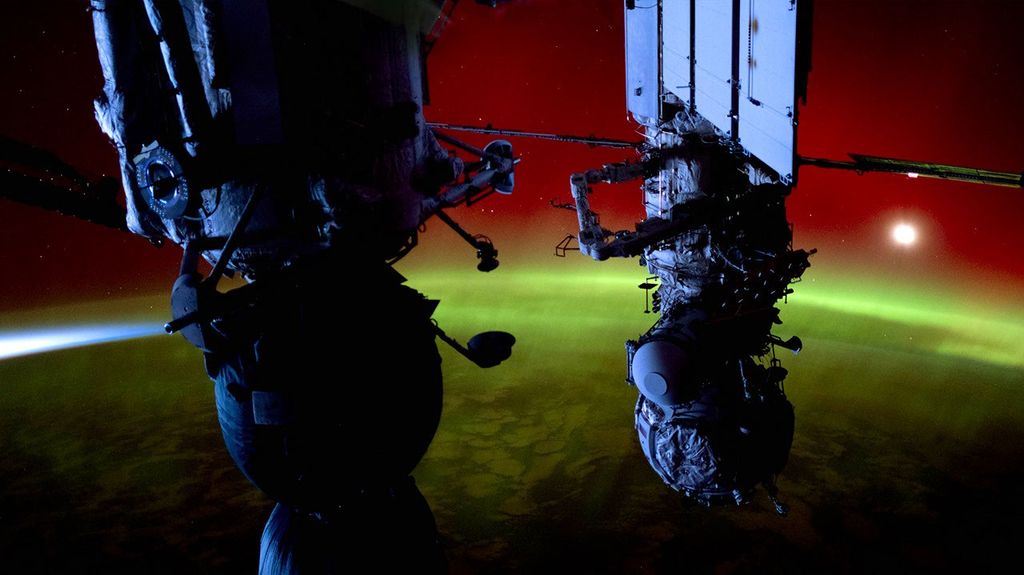1 min read
Postcards from Andromeda

Glittering stars. Distorted galaxies. A cluster of more than 100,000 stars. The celestial objects in this six-panel photograph are just a sampling of the more than 300,000 stars and the thousands of distant galaxies seen in the image of a small region of the Andromeda galaxy's halo, a spherical cloud of stars around the galaxy. The image was taken with the Advanced Camera for Surveys aboard NASA's Hubble Space Telescope.
This photograph shows some of the interesting details found in that image. The stars in these panels are located in Andromeda's halo. The galaxies seen in five of the panels represent some of the background galaxies located far beyond Andromeda. A few of them appear distorted, such as the curved red streak of material seen at top row, center. Their distorted shapes suggest that they collided with other galaxies. The white spherical object [bottom row, right] is a collection of more than 100,000 stars called a globular cluster, located in Andromeda's halo. Andromeda is located 2.5 million light-years from Earth.
The members of the M31 halo science team are: T.M. Brown, H.C. Ferguson, E. Smith (STScI); R.A. Kimble, A.V. Sweigart (NASA/GSFC); A. Renzini (ESO); R.M. Rich (UCLA); and D.A. VandenBerg (U. of Victoria)
About the Object
- R.A. PositionR.A. PositionRight ascension – analogous to longitude – is one component of an object's position.00h 46m 8.14s
- Dec. PositionDec. PositionDeclination – analogous to latitude – is one component of an object's position.40° 42' 36.36"
- ConstellationConstellationOne of 88 recognized regions of the celestial sphere in which the object appears.Andromeda
About the Data
- Data DescriptionData DescriptionProposal: A description of the observations, their scientific justification, and the links to the data available in the science archive.
Science Team: The astronomers who planned the observations and analyzed the data. "PI" refers to the Principal Investigator.hese data are from the HST proposal 9453 by T.M. Brown, H.C. Ferguson, E. Smith (STScI), R.A. Kimble, A.V. Sweigart (NASA/GSFC), A. Renzini (ESO), R.M. Rich (UCLA), and D.A. VandenBerg (U. of Victoria).
The members of the M31 halo science team are: T.M. Brown, H.C. Ferguson, E. Smith (STScI); R.A. Kimble, A.V. Sweigart (NASA/GSFC); A. Renzini (ESO); R.M. Rich (UCLA); and D.A. VandenBerg (U. of Victoria) - InstrumentInstrumentThe science instrument used to produce the data.HST>ACS/WFC
- Exposure DatesExposure DatesThe date(s) that the telescope made its observations and the total exposure time.December 2002 and January 2003, Exposure Time: 3.5 days
- FiltersFiltersThe camera filters that were used in the science observations.F606W (Wide V), F814W (I)
- Object NameObject NameA name or catalog number that astronomers use to identify an astronomical object.NGC 224, M31, Andromeda Galaxy Halo
- Object DescriptionObject DescriptionThe type of astronomical object.Spiral Galaxy in Local Group, Galaxy Halo
- Release DateMay 7, 2003
- Science ReleaseDeepest View of Space Yields Young Stars in Andromeda Halo
- Credit
Related Images & Videos

Young and Old Stars Found in Andromeda's Halo
The deepest visible-light image ever taken of the sky resolves approximately 300,000 stars in the halo of the nearest neighboring spiral galaxy, Andromeda (M31). The photo was taken with the Advanced Camera for Surveys aboard NASA's Hubble Space Telescope. Because the image...

Zoom into ACS Image of M31 Halo
A Zoom into the constellation Andromeda reveals the magnificent galaxy M31. Zoom continues to Hubble's Advanced Camera for Surveys image of a small portion of the M31 halo of stars. This spherical halo of stars surrounding the neighboring Andromeda galaxy has revealed...

Pan Across ACS Image of M31 Halo
Pan sequence of the Hubble's Advanced Camera for Surveys image of the M31 halo. The camera moves across various sections of the deep field, revealing myriad galaxies and stars. The complete Hubble view contains several hundred thousand stars and thousand of background galaxies.
Share
Details
Claire Andreoli
NASA’s Goddard Space Flight Center
Greenbelt, Maryland
claire.andreoli@nasa.gov










































